Young climate activists warn their elders Stop destroying the planet
After the cops showed up in an urban forest and detained Manisha Dhinde, one of them asked her: “What is this fashion of protesting for the environment?â€
“It isn’t fashion,†Dhinde snapped back on that day two years ago. “It is my duty to save trees.â€
She was opposing plans to cut down 2,700 trees in order to build a metro train car shed on tribal land in Mumbai. That moment galvanized the petite woman with the deep voice, and now she is aiming to work with marginalized communities across her state of Maharashtra to stop or at least reshape development projects that would harm the environment.
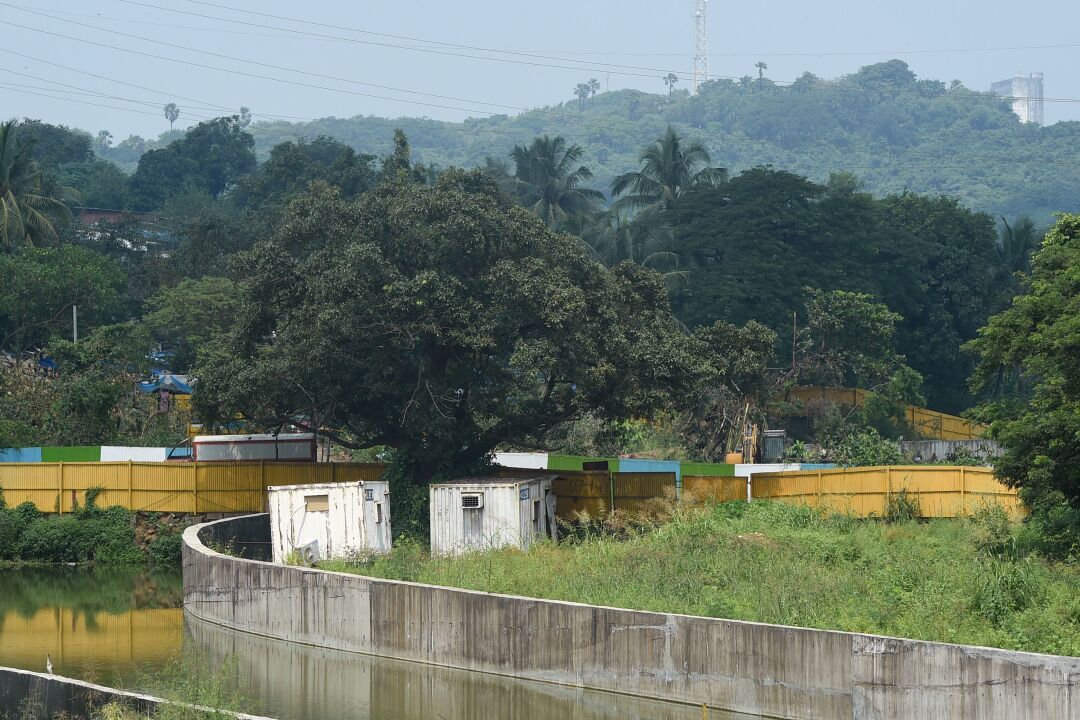 A construction project planned for an urban forest in Mumbai, India, awakened a young woman’s environmental activism.(Punit Paranjpe / AFP/Getty Images)
A construction project planned for an urban forest in Mumbai, India, awakened a young woman’s environmental activism.(Punit Paranjpe / AFP/Getty Images) “We don’t respect anyone more than we respect nature,†Dhinde, 22, said of the tribes living on shrinking green space in this traffic-congested, air-polluted city.
Dhinde is part of a surge of young environmentalists determined to stave off climate change by challenging the destructive ways of their elders. In Uganda, a climate activist who once worked in her family’s battery supply shop has found international fame for bringing Africa and the Global South into the conversation. In Scotland, a woman who quit college to warn of rising temperatures and a troubling carbon footprint is battling politicians and corporations she accuses of attempting to co-opt and distort the climate change movement.
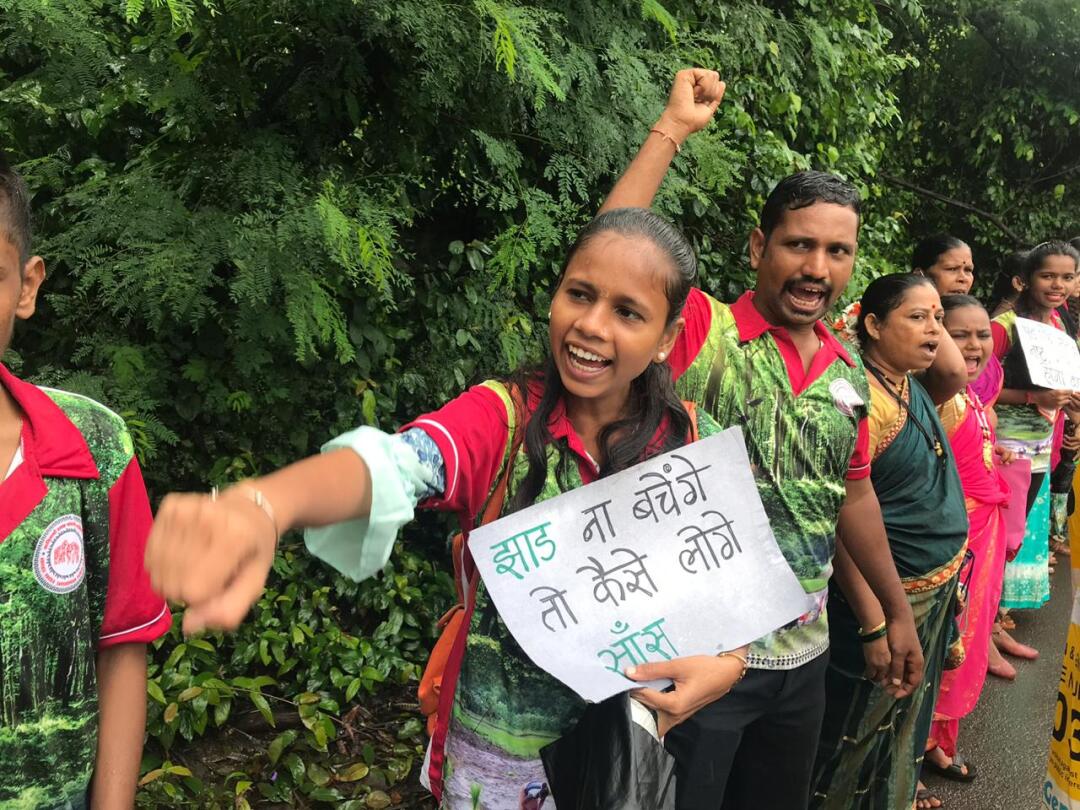 “It is my duty to save trees,†Manisha Dhinde says.(Amrita Bhattacharjee)
“It is my duty to save trees,†Manisha Dhinde says.(Amrita Bhattacharjee) All three are part of the first generation to come of age at a time when the effects of the climate crisis are already being felt â€" foreshadowing a perilous future. Their fight is propelled by the technology they have mastered: unparalleled access to information and to one another â€" thousands of miles but only milliseconds apart on the social media platforms that have heralded their cause. Some, like Swedish activist Greta Thunberg, have become brands themselves, testifying at hearings and admonishing lawmakers and bureaucrats.
The World They Inherit
The World They Inherit
This is the fifth in a series of occasional stories about the challenges young people face in an increasingly perilous world. Reporting was supported by a grant from the Pulitzer Center.
Their confrontational strategy is reminiscent of the young antiwar and civil rights protesters of the 1960s. But the existential stakes are much higher today. Disillusioned by economic and political designs that have long favored big industry and fossil fuels over the environment, this generation faces the prospect that entire regions of the world will become increasingly uninhabitable. Their TikTok videos and social media scrolls are a kaleidoscope of climate refugees, sinking cities, parched farmlands and endangered wildlife.
“The planet is warming, the animals are disappearing, the rivers are dying, and our plants don’t flower like they did before,†Txai SuruÃ, a 24-year-old Indigenous climate activist from the Brazilian Amazon, told world leaders on the opening day of the United Nations COP26 summit in Glasgow, Scotland, this week. “The Earth is speaking. She tells us that we have no more time.â€
By any measure, the outlook is grim. Oceans are hotter than they’ve ever been and the rate of sea level rise has doubled since 2006. Carbon dioxide levels in the atmosphere haven’t been this high in 2 million years. More than 1 million plants and animal species are at risk of extinction. No matter what changes are made today, the young will inherit a planet that over the next 30 years will see worsening heat waves, droughts and flooding, according to a recent United Nations report. The effects of greenhouse gas emissions, it said, are “irreversible for centuries to millennia.â€
The impact will be most profound for the young in poorer countries. In Africa, where the population is growing at twice the rate as in South Asia or Latin America, and is expected to double by 2050, the number of youths being born into a warming climate is booming. Almost half of the populations of many African countries, including Niger, Mali, Uganda and Congo, are under age 15. Those young are already living through the crisis. Cyclones have torn through the south; desert locusts have endangered the food supply in the east; the Nile River’s water supply is unsteady.
“It’s not the devastation that keeps us fighting. It’s what we see in our minds â€" the vision, the hope,†said Vanessa Nakate, an activist from Uganda. “Because if there’s no hope, what are we to look forward to?â€
::
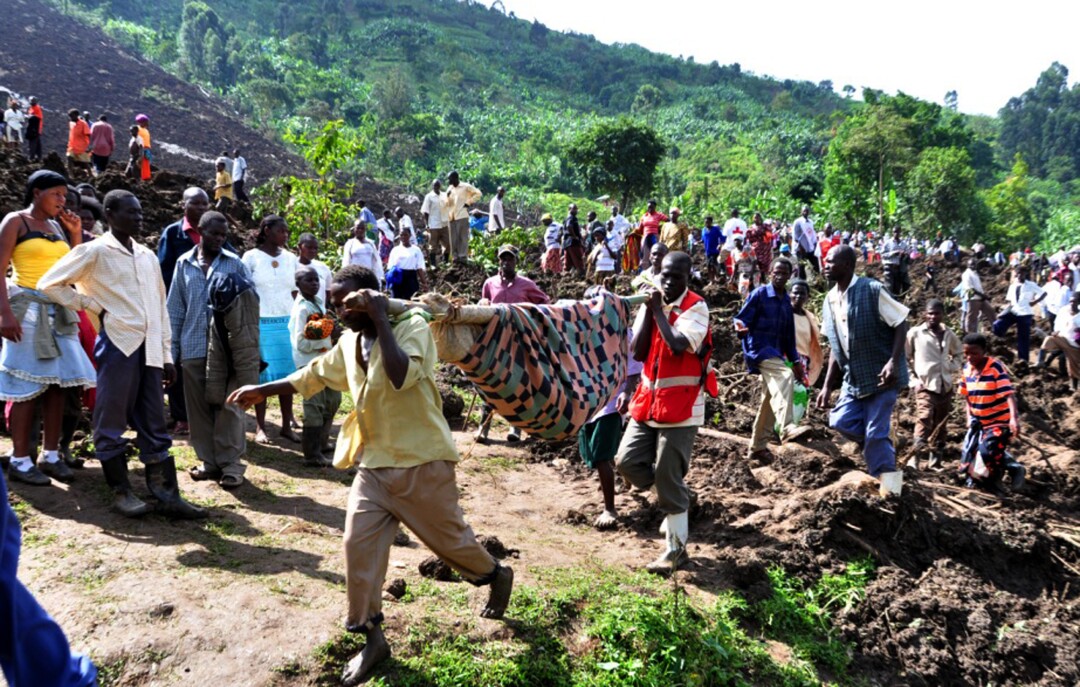 A landslide in eastern Uganda killed dozens of people in 2010.(Peter Busomoke / AFP/Getty Images)
A landslide in eastern Uganda killed dozens of people in 2010.(Peter Busomoke / AFP/Getty Images) Nakate was having trouble falling asleep in her sweltering attic bedroom in Kampala. It was 2018, and so hot and dry, farmers had noticed their yields were suffering. Then came the floods. Nakate watched in horror as rising waters and landslides in eastern Uganda drove 21,000 people from their homes. More than 50 people died, including children buried in the mud of an elementary school.
 “It’s not the devastation that keeps us fighting. It’s what we see in our minds â€" the vision, the hope,†said Vanessa Nakate, a climate activist from Uganda. “Because if there’s no hope, what are we to look forward to?â€(Esther Ruth Mbabazi)
“It’s not the devastation that keeps us fighting. It’s what we see in our minds â€" the vision, the hope,†said Vanessa Nakate, a climate activist from Uganda. “Because if there’s no hope, what are we to look forward to?â€(Esther Ruth Mbabazi) It seemed extreme weather events were becoming more frequent and lasting longer. She asked her Uncle Charles whether she was imagining things. He told her that the world was in trouble.
Nakate was shy and introverted â€" nothing like the Greta Thunberg she saw on social media. She worried she would be mistaken for a prostitute if she staged a one-woman protest at a busy Kampala intersection. But compelled to act, she enlisted her siblings and cousins and made posters: Nature is life; climate strike now; thanks for the global warming. So nervous she couldn’t feel her legs, she uploaded photos of their six-person strike to Twitter. Thunberg retweeted them, and Nakate’s act of defiance went viral.
A college graduate with a business degree, Nakate became a rare African voice in a chorus of young climate change activists. In early 2020, she was in Davos, Switzerland, sleeping in a tent despite subzero temperatures to prove an energy-efficient point during the World Economic Forum. But it was her skin color, not her environmentalism, that made her famous when she was trimmed out of a photograph with four white activists.
“They hadn’t just cropped me out, I realized,†she said. “They’d cropped out a whole continent.â€
That moment of humiliation in the Alps steeled her. She quickly emerged as a leading critic on the disproportionate impact of climate change on the Global South, or poorer regions outside of North America and Europe. The average person in Uganda, like other African countries, emits less carbon dioxide in a year than a person in the United Kingdom does in just two weeks, she said, but are the first to face extreme economic loss and forced migration.
The rate of sea level rise in countries like Madagascar is above average; more than half of the coastlines of Benin, Togo, Ivory Coast and Senegal are eroding; and thanks to extreme heat and flooding, disease-carrying mosquitoes are inhabiting new altitudes of the East African highlands. In some regions of Africa, the number of undernourished people has increased by almost 50% in the last decade.
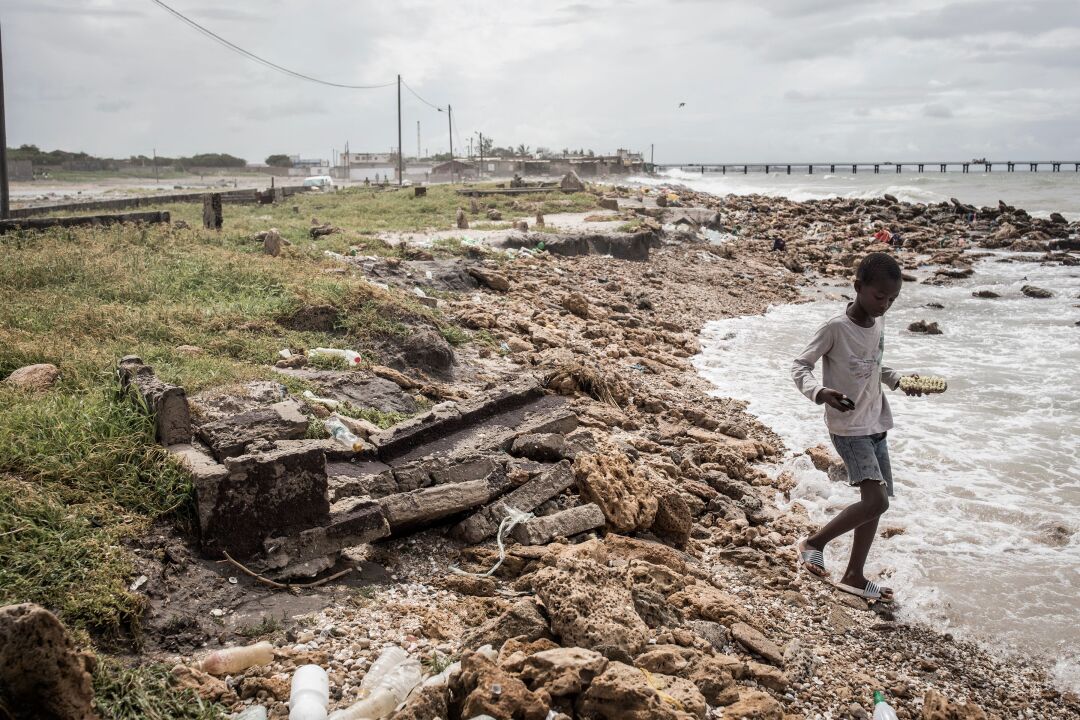 A boy walks past a destroyed tomb in a graveyard along an eroded coastline in Bargny, Senegal.(John Wessels / AFP/Getty Images)
A boy walks past a destroyed tomb in a graveyard along an eroded coastline in Bargny, Senegal.(John Wessels / AFP/Getty Images) “For our country, drought means hunger, starvation and death,†Nakate said. “We see it as it is â€" not what’s coming in the future, but what’s here already, right now.â€
During the pandemic, she saw it in real time, as Ugandan households under stay-at-home orders were flooded by the rising waters of Lake Victoria. Nakate’s frustration intensified as government officials urged people to follow science in combating the COVID-19 pandemic but, in her view, weren’t following science on climate change.
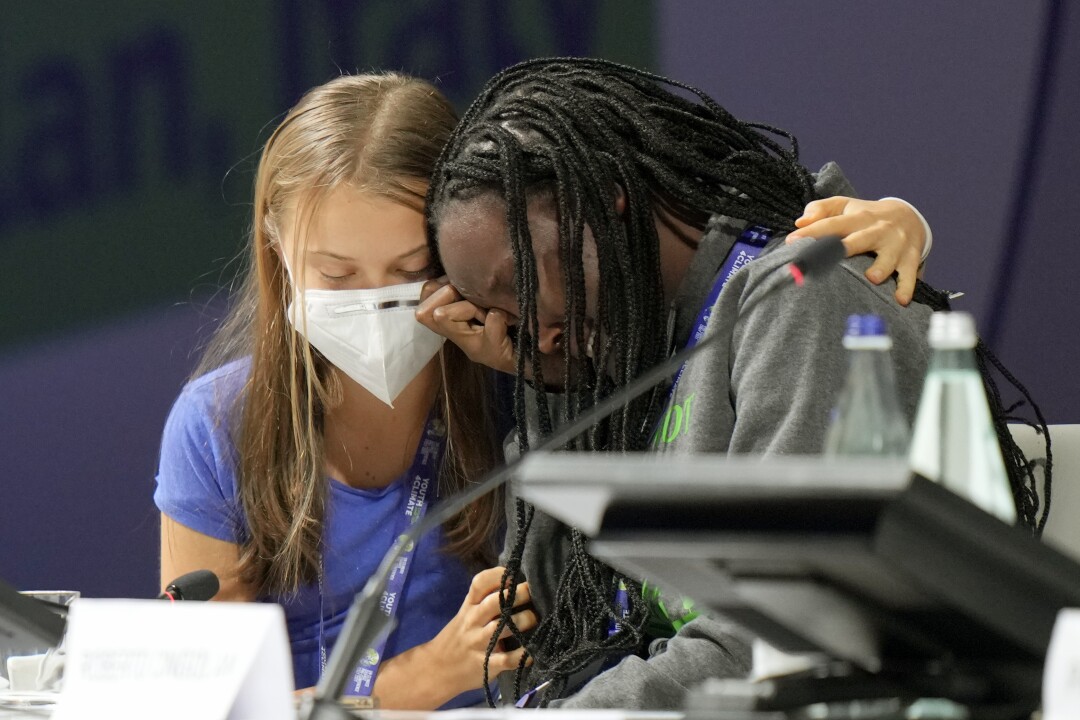 Vanessa Nakate, right, is comforted by Greta Thunberg at a climate summit in Italy in September.(Associated Press)
Vanessa Nakate, right, is comforted by Greta Thunberg at a climate summit in Italy in September.(Associated Press) Nakate wears a hoodie, listens to Taylor Swift music and, like others in her generation, has taken much of her advocacy online, communicating through a WhatsApp account tagged with a sunglasses emoji. She believes that social media have helped young people around the world, including in the United States, understand the immediacy of the crisis in her country. Like many of her climate compatriots she has the aura of a tireless prophet, logging thousands of miles to spread her message, most recently traveling to Scotland for the U.N. summit.
She’s published a new book and is keen with a sound bite: “Every activist has a story to tell, every story has a solution to give, every solution has a life to change.â€
At home she knows all activism is local and deeds have quiet power. She has taken to installing solar panels in Ugandan schools and meeting with students. She believes girls in particular are the “first responders†to the climate crisis â€" and, given the current roster, she points out, that’s hard to contest.
“I’d have three children right now if I hadn’t gone to school and researched the environment,†she said. “Climate justice and gender equality are intertwined: If half of all the players sit on the sidelines, our entire planet is going to lose.â€
::
It was the evening before the biggest day of her young life, and Lauren MacDonald was having a panic attack.
Her stomach was doing flips and her hands were trembling. Her friends, a group of other young climate activists from around the world, soothed her. Then they stayed up with her until the early morning helping her write and practice the speech that would make her a viral sensation.
“I just want to start by saying that you should be absolutely ashamed of yourself for the devastation that you have caused to communities all over the world,†MacDonald said the next day to one of the world’s most powerful oil men, interrupting an otherwise staid panel discussion on climate change with an all-out declaration of war.
The crowd at the TED Countdown Summit in Edinburgh, Scotland, gasped and Ben van Beurden, the chief executive of Royal Dutch Shell, stared down at his feet. Van Beurden had just spoken at length about his company’s vow to cut its carbon emissions in the coming decades when MacDonald, an activist who had led TED officials to believe she would be giving a more decorous speech, went into attack mode.
“Every single day that you fail to stop making evil decisions is a day that the death toll from the climate crisis rises,†she said.
MacDonald criticized Shell’s continued exploration for new oil and its history of sowing public doubt about climate science, dismissing the company’s carbon-reduction pledge as nothing more than “greenwashing.†She then unhooked her microphone and left the stage.
 “Every single day that you fail to stop making evil decisions is a day that the death toll from the climate crisis rises,†activist Lauren MacDonald told one oil executive.(Alexander Hoyles)
“Every single day that you fail to stop making evil decisions is a day that the death toll from the climate crisis rises,†activist Lauren MacDonald told one oil executive.(Alexander Hoyles) Overnight, MacDonald became another outspoken star of a global movement. While she faced criticism from some corners for not engaging Van Beurden in dialogue at the event last month, many others rejoiced in watching a plucky 21-year-old berate a man whose company is one of the world’s largest producers of CO2 emissions.
Speaking over a video chat a few days later, MacDonald was dazed. “Being elevated to a world stage is very new,†she said from her bedroom in Glasgow, once a major shipbuilding town with smoke-heavy skies. “I feel really blessed, but also very overwhelmed.â€
Born in a working-class family, she first learned about climate change in high school when a friend explained why she was vegan. Soon MacDonald had stopped eating animal products and was spending all of her free time organizing climate strikes. She dropped out of university after a few semesters, convinced that activism was more urgent than her studies.
She has confronted powerful leaders before, including Nicola Sturgeon, the head of the Scottish government.
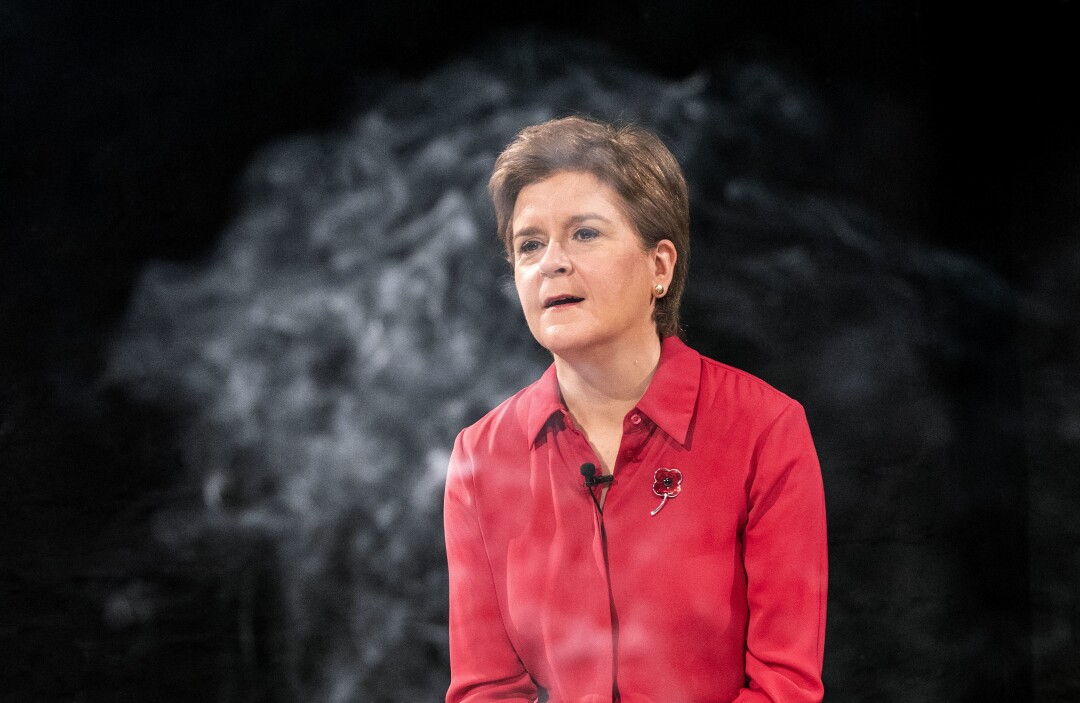 Nicola Sturgeon, the head of the Scottish government, was confronted by climate activist Lauren MacDonald.(Jane Barlow / AFP/Getty Images)
Nicola Sturgeon, the head of the Scottish government, was confronted by climate activist Lauren MacDonald.(Jane Barlow / AFP/Getty Images) “I worry every day,†she told Sturgeon in video that went viral, demanding that she commit to opposing Cambo, a new oil field off Scotland’s coast. “I have genuine existential crises when I think about my future.â€
Sturgeon appeared moved by the emotional plea. “I hear what you say, and I have a lot of sympathy,†she said. But ultimately she sidestepped the issue of the oil field.
MacDonald says her mental health has suffered â€" both from anguish about the irreversibly changing world and the feeling that she must carry more of that weight as others look away.
“We need more people to be taking on this burden to share it between people,†MacDonald said.
While people called her brave for challenging Van Beurden, she said the confrontation was painful. “The work that I do and that so many other people are doing is not easy. It’s heartbreaking,†she said.
She does the work for her little sister.
“I want to do everything that I can to mitigate like devastation for the people that I love,†she said. “I think that it’s so important to have the audacity to keep trying.â€
::
The protest that led to Manisha Dhinde’s arrest in Mumbai just before the pandemic was to oppose a construction project in the Aarey Colony, an urban forest of some 32,000 acres. It is home to vulnerable species â€" leopards, sambar deer, dozens of types of butterflies â€" and consists of 27 tribal hamlets, or forest-dwelling communities, including her own.
“The authorities always keep tribals in the dark,†she said of the state’s plan to build the metro train car shed. “We weren’t even asked or considered, even though we live here.â€
Even after her arrest â€" on the way to her school exams â€" she and others kept at it, attending public hearings and forming blockade chains until the project fell through. That was her first encounter with environmental activism. But the protest to save the forest in Aarey Colony introduced her to other environmental problems in India, a country of 1.4 billion people where some regions have seen temperatures of more than 123 degrees Fahrenheit in recent years.
 India’s government officials always keep tribal communities “in the dark,†Manisha Dhinde says. “We weren’t even asked or considered, even though we live here.â€(Amrita Bhattacharjee)
India’s government officials always keep tribal communities “in the dark,†Manisha Dhinde says. “We weren’t even asked or considered, even though we live here.â€(Amrita Bhattacharjee) One of those problems is Prime Minister Narendra Modi’s plan to connect the capitals of Maharashtra and his home state of Gujarat with a bullet train. It is supposed to run through the tribal district of Palghar â€" about 75 miles north of Mumbai â€" and displace 41 villages. Development projects â€" as they do in many countries â€" affect the poor disproportionately even as they fell forests, whose trees cleanse carbon from the air, and spoil the land for those who live off it.
Dhinde says that no matter how much the tribal communities resist, they are eventually coaxed into submission. “Tribals never benefit from these projects,†she says. “It is always the large corporations and the state.â€
Dhinde is fierce and direct, if not exactly imposing. She’s thin with a deep voice and brisk walk.
She sees the connection between razing trees and the climate. Eccentric weather patterns in India mean consistent losses to agriculture and farmers, on whom India’s rural economy depends, or nearly 70% of the country’s population. Dhinde knows a thing or two about it. During the day she works on her family’s three-acre farm, where they cultivate rice and vegetables, as they have for generations.
Dhinde is part of the Tribal Rights Protection Committee in the Aarey Colony, where she and others research and share the potential consequences of construction projects, ensuring that “every tribal here gets the information that the authorities are trying to hide.†She is also pursuing a degree in social work, confident it will help fight for the most marginalized.
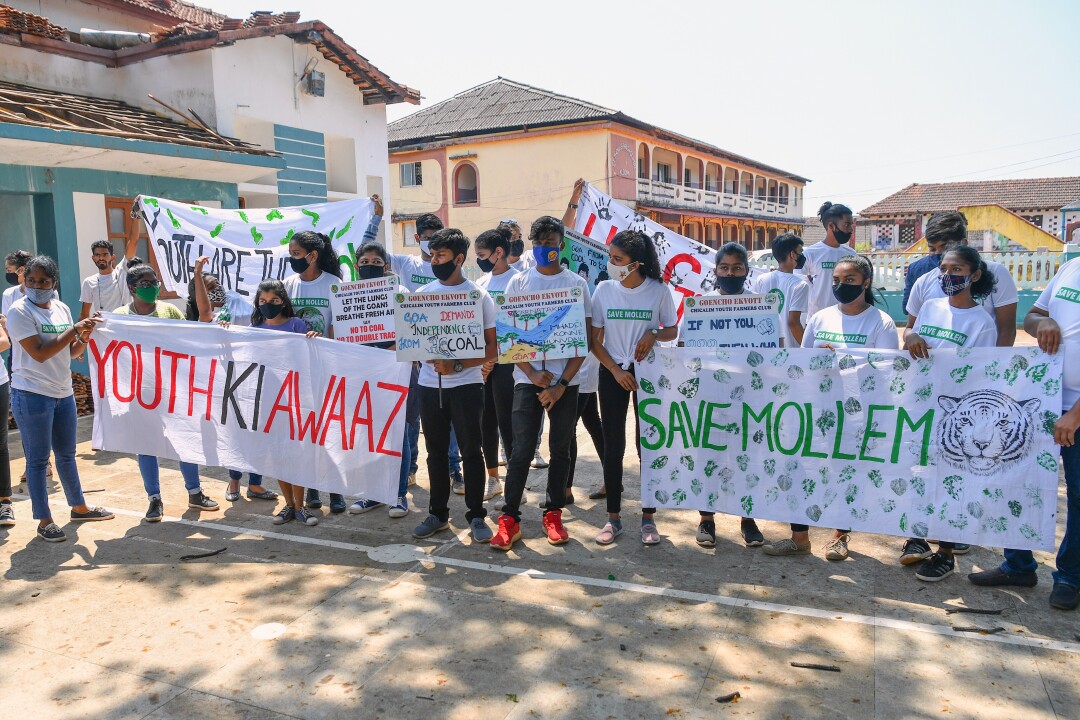 Young environmental activists demonstrate in India.(Ndranil Mukherjee / AFP/Getty Images)
Young environmental activists demonstrate in India.(Ndranil Mukherjee / AFP/Getty Images) As the coronavirus continues circulating, the group meets in person only when necessary. But Dhinde keeps the communication strong: She takes pictures for the group’s Twitter page, @ConserveAarey, and Instagram account, @AareyForest, to help share information about the tribal communities across India to ensure their voices are heard.
“Times have changed,†she says of social media. “You realize you are not alone.â€
Dhinde, like her counterparts in Uganda and Scotland, knows that, even if the razing halted and carbon emissions ceased today, the effects of past warming would still be felt for decades. She is not fighting a distant abstraction, but rather an altered world whose climate dangers will be with her until she dies.
Parth M.N. is a special correspondent. This is the fifth in a series of occasional stories about the challenges the young face in an increasingly perilous world. Reporting for the series was supported by a grant from the Pulitzer Center on Crisis Reporting.
0 Response to "Young climate activists warn their elders Stop destroying the planet"
Post a Comment